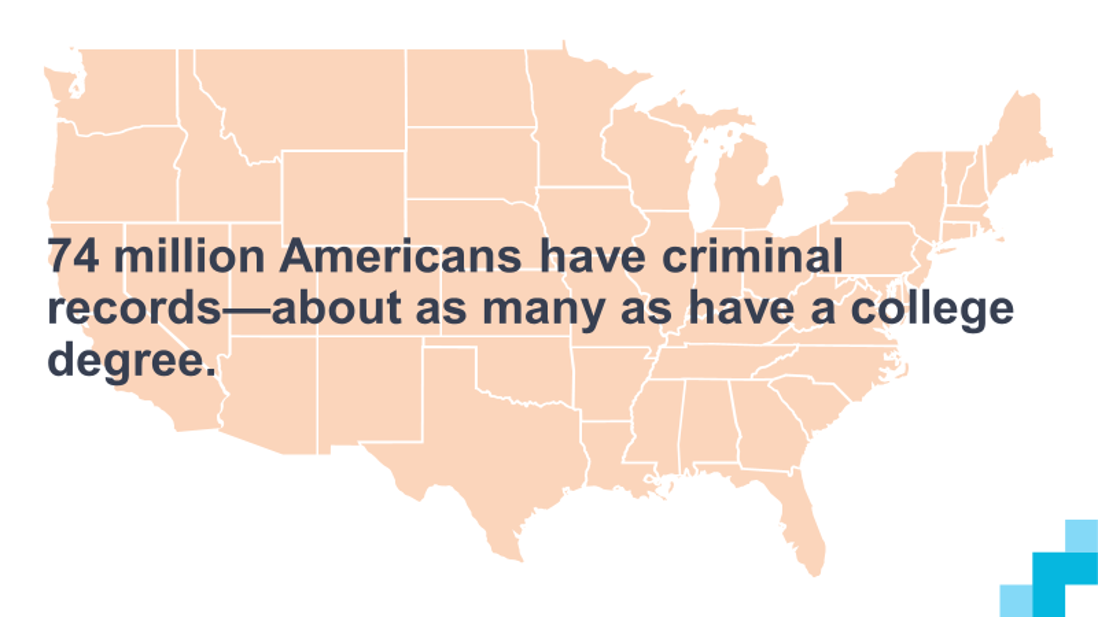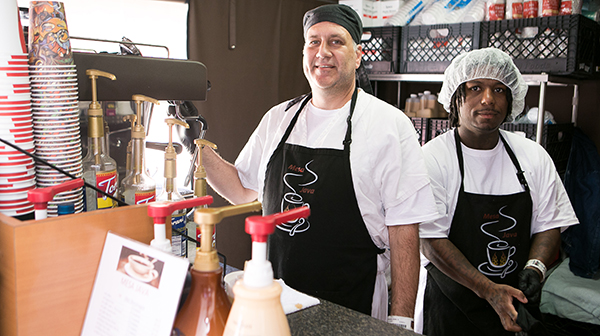Understanding the inextricable linkages between systemic racism, criminal justice and our ability as a nation to offer economic opportunity for all
By Andrew Picard, Chief Programs Officer @AndrewPicardSD; Research by Daniel Enemark, Ph.D., Senior Economist @danielenemark
The evidence of racial bias in our criminal justice system is overwhelming. But a critical piece of that conversation that isn’t as often addressed is the interrelation of racism in the justice system and the impact that reverberates out to our economy and workforce—which have lasting consequences for our society.
The average cost to incarcerate an individual in California is $75,000–greater than the tuition, room and board cost to send someone to Harvard University for the year. And yet, 74 million Americans have criminal records—about as many as have college degrees.
We’ve been sharing data in our series of articles focused on equity demonstrating the disparities faced by Black, Indigenous and People of Color (BIPOC), and other marginalized communities. Yet despite the overwhelming evidence, I find myself still hearing this problematic argument that poverty or unemployment stand alone as the causes of disparities, not systemic racism.
But in fact, racism perpetuates poverty among BIPOC and leads communities to be stratified into living in neighborhoods that lack the resources of white peers with similar incomes. They are interrelated, to be sure, but study after study show that even after adjusting for socio-economic factors, racial inequity persists.
A Deeper Look at Disparities Between Incarceration and Economic Mobility
Sharing this data to demonstrate systemic racism often wrongly interprets this as an accusation that everyone in the system is racist. In fact, systemic racism means almost the opposite. It means that we have systems and institutions that produce racially disparate outcomes, regardless of the intentions of the people who work within them.
Discrimination in the justice system—whether in policing, criminal prosecutions, trials, sentencing or imprisonment—is directly related to the poverty and economic mobility of our society. Though our laws are much less explicitly racist today than they have been in the past, our public and private institutions continue to discriminate against BIPOC.
When providing this data to the community, I’ve heard so many common and problematic retorts:
So are you saying all cops and judges are racist?
Name one racist law; there are no racist laws, so racism can’t exist.
Sharing data to demonstrate systemic racism often wrongly interprets this as an accusation that everyone in the system is racist. In fact, systemic racism means almost the opposite. It means that we have systems and institutions that produce racially disparate outcomes, regardless of the intentions of the people who work within them.
Here are just a few examples in our local and national justice system:
- In 2013, Black Americans smoked marijuana at the same rate as whites, but 4x more were arrested for possession
- San Diego Sheriff’s stop Black people at 2x the rate of white people; San Diego Police stop them 3x as much
- San Diego Police search Black drivers nearly twice as often, even though they’re 57% more likely to find something when searching whites
- Black San Diegans are 5x more likely to get prosecuted for minor drug offenses than whites and Hispanics
How Racial Discrimination Holds All of Us Back
There is a direct link between the bias within the justice system and the bias faced upon release. This is most evidenced by a 2019 study that sent out fictititous resumes to employers, comparing Black and white applicants with identical resumes and randomly assigning a criminal record. The results below should not surprise you that white people were more than twice as likely to get a call back, even with a felony record!
Racial inclusion and income equality are key factors driving regional economic growth. According to the Center for American Progress, racial inclusion is positively associated with growth in employment, output, productivity and per capita income. Regions that became more equitable in the 1990s—with reductions in racial segregation, income disparities or concentrated poverty—experienced greater economic growth as measured by increased per capita income.
Systemic biases affect all of us and prevent us from achieving our full potential as a country. We can never truly become a land of opportunity while we allow racial inequity to persist. And ensuring equal opportunity for all is in our shared economic and societal interest.
We’re a better country when we make sure everyone has a chance to meet their full potential.
Hiring Justice-involved Individuals Helps a Business’ Bottom Line
 Increasing diversity in the workplace impacts the bottom line. Many studies have found out that companies with more diverse top teams were also top financial performers.
Increasing diversity in the workplace impacts the bottom line. Many studies have found out that companies with more diverse top teams were also top financial performers.
At Johns Hopkins Medicine 20 percent of entry-level hires have a criminal record. A five-year study of 500 individuals found lower turnover and zero problematic terminations. In their words, hiring these workers is “not a charitable endeavor but a strategic part of the way we conduct our business.”
Companies with a diverse workforce make better decisions faster, which gives them a serious advantage. As a result, companies with diversity in the workplace achieve better business results and reap more profit.
Resources available for businesses open to hiring those with a criminal background:
- Employers hiring justice-involved workers are eligible for $2,400 in Work Opportunity Tax Credits
- California provides “new employment” state tax credits for wages paid to employees with a felony conviction
- Federal Bonding Program: $5,000 of fidelity bonding for first six months
Our Work Focused on the Justice-involved

In addition to sharing reports and data intended to bring light to these issues in San Diego County, we are operating programs within and outside of correctional facilities specifically aimed at serving justice-involved individuals.
About Reentry Works
Evidence continues to demonstrate critical links between employment and successful reentry of justice-involved individuals into our community. Reentry Works invests and innovates in evidence-based solutions to best serve the justice-involved population by providing pre-release employment and training services, links to jobs and post-release employment services, earn and learn opportunities, supportive services and community-based connections.
Job Centers in Jails
The San Diego Workforce Partnership collaborates with Second Chance, the San Diego County Probation and Sheriff’s departments and other key organizations to run career centers within the East Mesa Reentry Facility and Los Colinas Detention and Reentry Facility.
Outcomes:
- State Average Recidivism Rate = 65%
- Our Participants’ Recidivism Rate = 18%
- Average Job Placement Rate = 80%
Prison to Employment
The latest addition to Reentry Works is Prison to Employment (P2E), a three-year, $37 million grant to integrate workforce and reentry services across California. The goal is to serve justice-involved individuals by creating a systemic and ongoing partnership between rehabilitative programs within the California Department of Corrections and Rehabilitation (CDCR) and the state workforce system. The program goal is to serve 250 individuals through post-release employment services. Second Chance—in coordination with multiple partners—provides P2E services to ease the reentry transition, provide housing and basic need stabilization, direct job placement and reduce recidivism.
What We Have Learned Serving the Justice-involved
Moving forward in our work to drive equity across those involved in the justice system, we’ve uncovered these key themes:
- Change is driven by trusting relationships. This includes partnerships across supporting organizations and justice-involved individuals and supporting organizations.
- If organizations seek to support justice-involved individuals, the best time to reach them is before they are released from custody
- A job alone is often not always the first step toward self-sufficiency: If justice-involved individuals believe all an organization cares about is achieving employment placements, they won’t communicate challenges that are relevant to their path toward self-sufficiency
- Organizations that want to support this population need to agree on a model of service that provides justice-involved individuals experience over the operational preferences of their organizations

